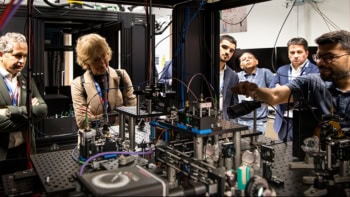Physicists in the US have demonstrated a simple way to entangle "qudits". Just as a quantum bit or "qubit" can be in two different states at the same time, a qudit can simultaneously exist in d states. Malcolm O'Sullivan-Hale and co-workers at the University of Rochester have demonstrated d=3 and d=6 qudit states with photons. The result could have applications in quantum cryptography (Phys. Rev. Lett. 94 220501).
Conventional computers store information as “bits”, which can have a value of 1 or 0. However the ability of photons and other quantum particles to exist in two different states at the same time — such as horizontal and vertical polarization states — has lead to a new science of quantum information processing. Moving from two-dimensional qubit states to higher dimensional qudit states allows the particles to carry even more information and, for example, to increase security against eavesdroppers in quantum cryptography applications.
O’Sullivan-Hale and co-workers began by shining an ultraviolet laser beam onto a crystal with nonlinear optical properties that sometimes splits an ultraviolet photon into a pair of entangled infrared photons. Entanglement means that the properties of the photons — such as their polarization — are much more strongly correlated than is possible in classical physics. For instance, it is possible to entangle photons such that if one has clockwise circular polarisation, then the other will always be polarized in the anti-clockwise direction.
The Rochester team actually entangle the momenta of the photons, which means that their positions in real space, as measured by a detector, are also entangled. In their experiment they show that the photons can occupy any one of six momentum or position states (or pixels). With larger detector arrays, the team says that it could increase this to 16 states.
“Although entangled qudits have previously been made by various methods, our method is attractive because of its comparative simplicity and scalability,” O’Sullivan-Hale told PhysicsWeb. “We work with simple, off-the-shelf imaging optics without the need for holograms or interferometric stability as in previous experiments.”
The team now plans to demonstrate pixel entanglement in a quantum cryptographic system. “We would also like to use our ideas to create high-dimensional states using other variables such as energy and time,” he adds.



